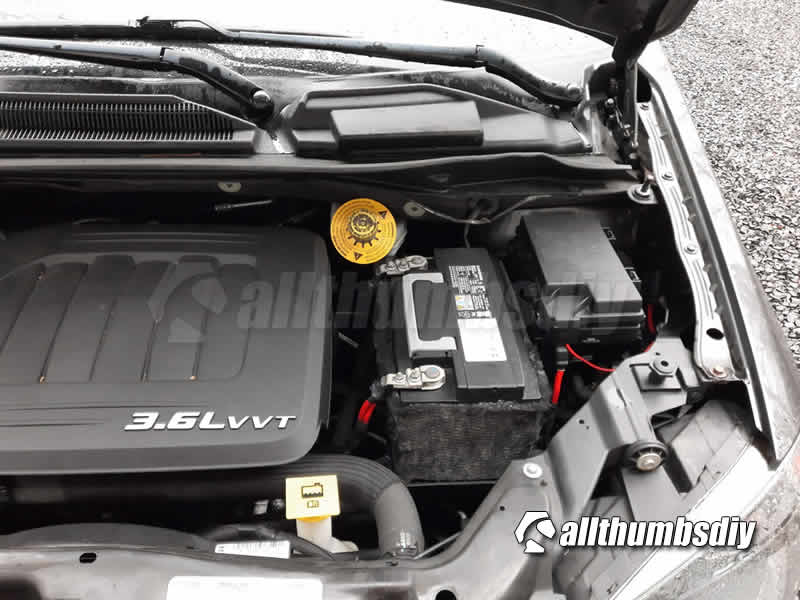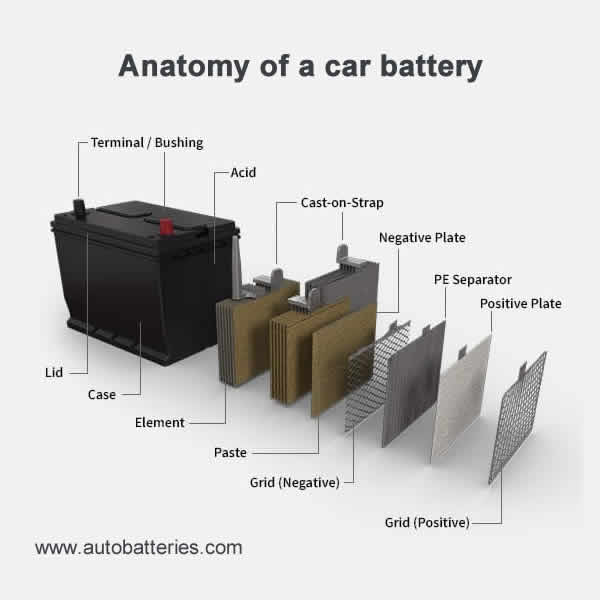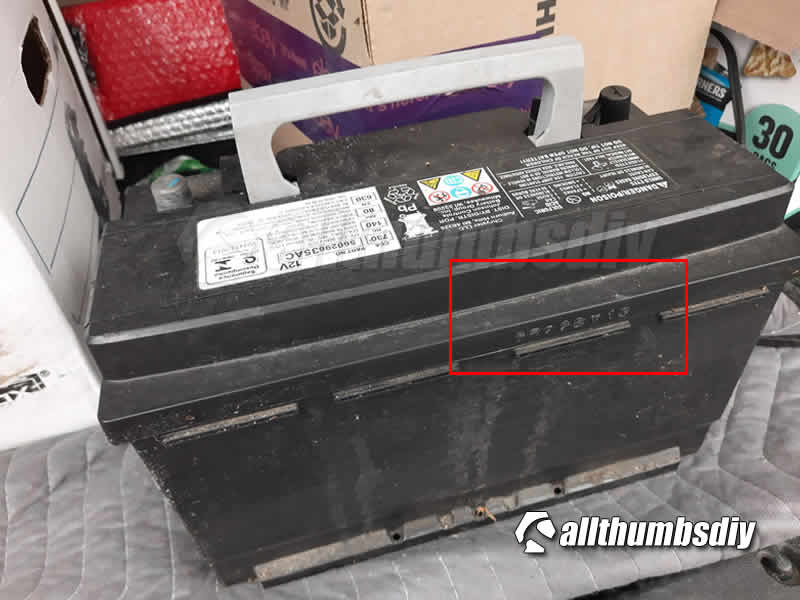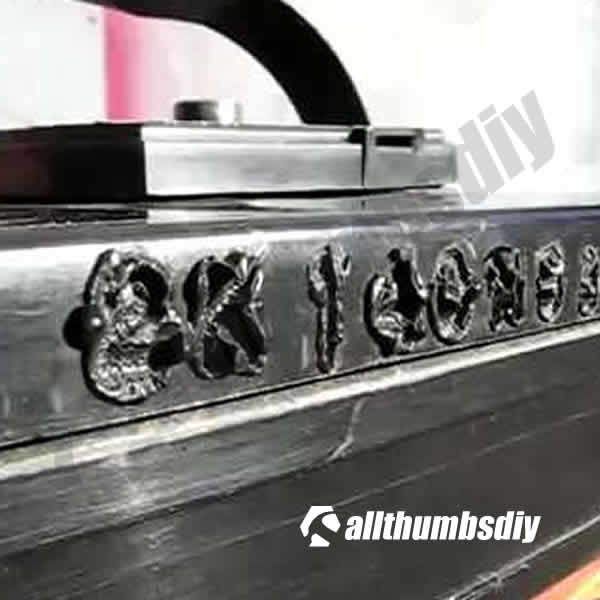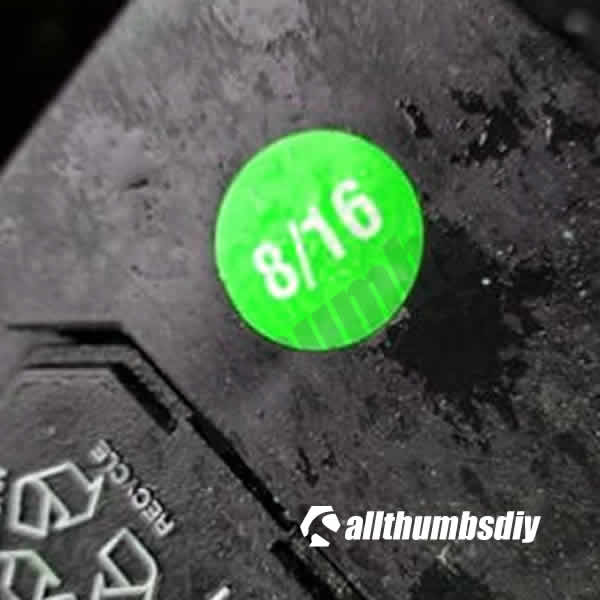Key Points
- A weak or failing car battery on a 2016 Dodge Grand Caravan can cause all sorts of error codes to a “ghost” or non-existent problems
- Learn how to properly maintain, diagnose and replace a battery for your Dodge Grand Caravan
- How Car Batteries Work
- Battery Types
- Anatomy of a Car battery
- Common Car Battery Terminologies
- Specification – Dodge/Chrysler OEM Battery
- What Causes a Battery to Fail?
- Common Symptoms of a Failing Battery
- Three Steps to Identify a Bad Battery
- How to Jump Start your Dodge Grand Caravan
- Buying a New Battery for Your Dodge Grand Caravan
- How to Replace the Old Battery
- Battery Care
- Frequently Asked Questions (FAQ)
- Related Posts
- Reference Links
How Car Batteries Work
An automotive battery works by storing energy in a chemical form that can be instantly converted to electricity on-demand.
This electricity is used by the vehicle ignition system to power the computer, a fuel pump, and a starter motor to start the vehicle (once the vehicle starts the engine, the alternator provides electricity needs).
When the engine is turned off, battery lights and accessories such as radios.
For more detailed information, I highly recommend reading “How a Car Battery Works” post from The Engineering Mindset site.
Battery Types
In diesel and gasoline engines, the most common battery type is SLI (Starting, Lighting, and Ignition).
An SLI battery is a rechargeable, lead-acid battery and this technology has been around for many years.
During the engine operation, an SLI battery is continuously charging and discharging electricity per vehicle’s electric load demand.
When the battery loses 5% of its total charge capacity, an alternator supplies current to the battery via rectifiers or diodes and converted to direct current (DC)
An SLI battery types typically supply the extra power when the electrical needs of a vehicle need extra power above the supply of the charging system. This feature can also be called a stabilizer.
In marine engine applications, a Deep Cycle battery is used to provide steady but lower power for a long period of time (deep discharge), thus it is not suitable for use in vehicle applications.
Deep cycle batteries use thick lead plates while SLI batteries use thinner plates consisting of lead-oxide
Deep cycle batteries can produce a short burst of power but SLI battery can provide far greater power curve on demand.
SLI batteries will also have longer life-span than deep cycle batteries because SLI battery is never fully drained
Anatomy of a Car battery
External Battery Components
- Battery Case – designed to minimize vibration and prevent cracking upon impact, this plastic resin case holds the internal battery components
- Terminal/ Bushing: Both negative and positive metal posts are connected to the negative and positive straps of the internal element assembly. Vehicle’s battery cables are attached to these posts
- Battery Lid – some models allow you to remove the lid so that you can add water if necessary but most modern batteries are sealed to the battery case (no maintenance is required)
Internal Battery Components
- Battery Acid – is an electrolyte, typically consisting of sulfuric acid and water, that allows chemical reactions to take place to convert chemical energy into electricity
- Cast-on Straps – are permanently welded to the top of each element assembly; straps are then connected to the internal side of a negative and positive terminals
- Battery Plate Assembly – are stacked with alternating positive and negative plates, welded at the top by a cast-on straps; each battery plate assembly resides into individual wet cell slots
- Negative Plates – each plate/grid is made from lead with spongy lead active materials
- Positive Plates – contains a metal grid with lead dioxide active materials
- Separator – a polyethylene sheet that separates the positive plates from the negative plates to direct electricity flow
- Battery Paste – consisting of a lead oxide mixture to create lead dioxide and sponge lead by adhering to the positive and negative battery grids
Common Car Battery Terminologies
- BCI Group – The Battery Council International (BCI) Group Number “fingerprints” a battery with the following characteristics: (a) dimensions (L x W x H), (b) voltage (6V or 12V), (c) polarity (right-hand front positive, left-hand front positive, etc.), (d) type terminals (top, side, “L”, etc.). The BCI Group Number does not designate a battery’s capacity; it merely defines the above-listed physical characteristics
- AGM (Absorbent Glass Mat) – A type of non-woven separator material composed almost entirely of glass microfibers that absorbs and retains the electrolyte, leaving no free electrolyte in the cell to spill. VRLA batteries made with this material are often referred to as “AGM” batteries
- Ampere-Hour (Amp-Hrs, Ah) – Ampere is a unit of electron (current) flow rate through a given circuit. Ah is a measurement unit by multiplying the current in amperes by the time in hours of discharge. For example, a battery that delivers 5 amperes for 20 hours delivers has 100 Ah capacity (5 amperes x 20 hours = 100 amp-hrs)
- Capacity – The capacity of a battery is specified as the number of amp-hrs that the battery will deliver at a specific discharge rate and temperature
- Cell – In a lead-acid battery, each “wet cell” has an open-circuit voltage of approximately 2 volts. Since there are six cells in a typical battery, the total output is rated at 12 volts
- Charge Acceptance – The quantity of current in Ah that a battery can accept at a specified temperature and charge voltage within a defined period
- Cold Cranking Amps (CCA) – Used to define a battery’s capability to provide excess startup power to start a gasoline or diesel engine in cold temperatures. Higher CCA indicates greater starting power of a battery (very useful in cold regions)
- Corrosion – The electrochemical reaction between metal plates and electrolytes gradually corrode metal plates, leading to a battery failure. Battery terminals are also subject to corrosion if they are not properly maintained (will increase electrical load which diminishes cranking power)
- Current (Alternating) (AC) – A current that varies periodically in magnitude and direction thus AC power is not used in car batteries
- Current (Direct) (DC): A steady electrical current flowing used in all car batteries
- Cycle – each cycle consists of one discharge and one recharge
- Deep Discharge – when each cell is fully discharged, the voltage falls below the final discharging voltage. A complete discharge will shorten the lifecycle of a battery
- Electrolyte – In a lead-acid battery, the electrolyte is sulfuric acid diluted with water to induce electrochemical reaction: PbO2 + Pb + 2H2SO4 = 2PbSO4 + 2H2O
- Gel – A suspended form of electrolytes by adding fine silica. A gel battery, also referred to as VRLA battery, prevents spillage upon impact
- Group Size – The Battery Council International (BCI) assigns numbers and letters for common battery types. There are standards for maximum container size, location and type of terminal and special container features
- Lead-Acid Battery: Battery made up of plates, lead and lead oxide (various other elements are used to change density, hardness, porosity, etc.) with a 35 percent sulfuric acid and 65 percent water solution. This solution is called electrolyte, which causes a chemical reaction that produces electrons
- Maintenance-Free – most modern car batteries are sealed and are maintenance free (no need to add water to the battery reservoir)
- Reserve Capacity (RC) – Rating used to represent a time that the battery will provide electricity when the alternator fails. RC is a time measurement expressed in minutes that a fully charged battery will deliver 25 amperes at 27°C (80°F) and maintain a terminal voltage equal or higher than 10.5 volts (1.75 volts per cell)
- Short Circuit – occurs when unintentional current-bypass happens in a circuit, most commonly due to broken or frayed wiring
- Starting, Lighting, Ignition (SLI) Battery – SLI is a rechargeable battery that supplies electric energy to an automobile to power the starter motor, the lights and the ignition system of a vehicle’s engine
- Volt – unit of measure for electrical potential or voltage
- Voltage Drop – the difference in the electrical potential (voltage) when measured across resistance or impedance (ohms)
- Valve-regulated lead-acid battery (VRLA) – AGM and gel are the two types of VRLA batteries. VRLA batteries do not have extra electrolytes and thus minimize water loss. VRLA batteries feature one-way safety vent valves to maintain correct pressure (less than 3 psi)
Specification – Dodge/Chrysler OEM Battery
- Mopar Part: # 56029635AC
- Voltage: 12V (2v per cell)
- CCA: 730 (rated at -18 degrees Celsius)
- RC: 140 min (rated at 25 degrees Celsius)
- Ahr: 80 (rated at 25 degrees Celsius)
- Manufactured Date: February, 2016 (6B22BY1G)**
Decoding Date Codes
Factory batteries come with heat-stamped date codes on the side of a battery or a punch-out date sticker on top.
In most cases, you can get the build date on the manufacturer information label, located on the driver side door jamb and deduce that your battery is approximately 3 to 4 weeks older than the vehicle manufactured date.
After-market batteries will come with a small circle sticker that has the manufacturing month and year.
Heat Stamp Date Decoder (2010 through 2019 models)
| Year Code | Month Code |
|---|---|
| 0 – 2010 | A – January |
| 1 – 2011 | B – February |
| 2 – 2012 | C – March |
| 3 – 2013 | D – April |
| 4 – 2014 | E – May |
| 5 – 2015 | F – June |
| 6 – 2016 | G – July |
| 7 – 2017 | H – August |
| 8 – 2018 | J – September |
| 9 – 2019 | K – October |
| L – November | |
| M – December |
What Causes a Battery to Fail?
There are many causes for a battery to deteriorate and ultimately fail.
Although the age of a battery is a large contributing factor, there are other factors that cause to shortened the lifespan of a battery.
Stratification
As the battery is repeatedly charged, an unequal concentration of electrolyte may occur due to density gradients changing from the bottom to the top of a cell.
This often happens in batteries that are recharged from a deep discharge (i.e. dead battery).
A repeated deep discharge / recharging cycles will worsen plate stratifications until softened bottoms of the positive plates which will ultimately fail.
To avoid stratification, you need to make sure that the alternator is in good working order and if . Equalization charging is a way to avoid acid stratification.
Sulfation
Sulfation is the natural byproduct when crystals form on plates inside a battery when a battery is discharged. In a normally operating battery, these crystals are dissolved back into electrolytes during a recharging cycle.
If a car is unused, the battery sat uncharged, or even completely discharged, these crystals will get larger and harden onto the plates which in turn lessens the chemicals needed in electrolytes as well as reduce the surface area (of a plate) for the chemical exchanges to occur.
Sulfation can also occur in:
- batteries stored or cycled in a partially discharged state at warm temperatures
- on a vehicle with lots of electrical accessories (i.e. amplifiers, extra lights, etc.)
- installed in an engine that is idling, or operating a vehicle at low speed
There is no good way for consumers to reverse a battery with excess sulfation which means the battery has to be replaced. To minimize the risk of excess sulfation, it is a good idea to maintain a working alternator, pay attention to the serpentine belt and periodically trickle charging the battery.
Fore more information, read “Applying ways to minimize sulfation” (Battery University).
Short Circuit
Short circuit describes an unintentional current-bypass that happens in a circuit, most commonly due to broken/frayed/loose wiring
Short-circuit can also happen inside a car battery which usually happens when the separators melt due to overheating. When this happens, the battery will run down quickly or may even catch fire.
The best way to see if your car battery has a short circuit is to take a voltage reading (zero volt indicates a short circuit).
Failing Alternator or Serpentine Belt
Another contributing factor to a battery failure is failing alternator and/or worn out serpentine belt which prevents the battery from fully recharging
Faulty Fuel Pump Relay (TIPM)
Parasitic draw caused by a faulty fuel pump relay can allow fuel pump motor to run 24×7, even with the car turned off.
Please refer to Troubleshooting TIPM article for more information.
Inactivity
Car batteries lose their charges over time so they require regular charging. If the battery is deep discharged, it will take hours to gradually restore it so you should drive your car at least once a week for 30 minutes or longer.
Corroded Terminals
Terminals exhibiting powdery or crusty materials increase resistance and prevents the battery from fully recharging
Common Symptoms of a Failing Battery
Depending on the environment and driving habits, some Caravan batteries may last 10 years or longer!
But in most situations, you should suspect a battery problem when you experience one or more of the following:
- Suddenly you minivan is slow to start (after turning the ignition key)
- Headlights and accessories power up, but does not crank at all
- No radio
- When starting, the engine may crank slowly, or not at all
- The battery warning light is illuminated
- The engine may stall
- Battery is old
- Battery does not recharge to full capacity (you will get an error message from a recharging device)
- Check engine light is on (may cause sensors to produce error codes due to low or intermittent voltage)
- Minivan starts after cranking but dies shortly thereafter
Three Steps to Identify a Bad Battery
If there isn’t enough electrical charge to start the engine or run electronics, the battery is considered to be dead.
It used to be that the first sign of a battery failure was the interior lights going dim but with modern cars using LED lights, this is no longer a good indicator.
So to get a solid information on the health of your Dodge Grand Caravan battery, I’ve outlined three testing steps.
Tools You Will Need
Before we begin, you will need a battery charger and a multimeter to conduct these tests.
You can borrow but these tools will be used repeatedly so you may want to consider purchasing them. I bought and use these items:
- Car batter charger – I use a Vector battery charger I purchased from Home Depot; this unit identical to this BLACK and DECKER Fully Automatic Battery Charger Maintainer
- Multimeter – I use a Klein Multimeter but before making a purchase, I suggest you first read my review of the Three Best Value Multimeters post
Step 1: Visual Inspection
The first and the easiest way to tell if a battery is failing is by looking at it. Some of the signs to look for:
- Corrosion by the terminal/posts
- Black soot near posts
- Any kinds of bumps or bulges on top or side of the battery
- Signs of leaks on the battery tray or battery insulation jacket
- Odor surrounding the battery compartment
Terminal corrosions
Corrosions are due to hydrogen gas that is released from the acid in the battery and mixed with surrounding air to form white/green powders/solids.
Since most modern batteries are maintenance-free and are sealed, corrosion usually means there is a crack in the battery housing.
Black soot near terminal posts
Soot usually indicates sparks caused by a short circuit. External short circuit is caused by a loose battery cable or frayed/broken wire somewhere in the vehicle wiring system.
Internal or battery short circuit can develop when an older battery is exposed to high vibrations/impacts and extreme heat.
Deformed Battery Housing
Bulging battery usually indicates it being overcharged or low fluid level.
Odor from the battery
Similar to terminal corrosions, any type of smell coming from the battery indicates a compromised battery housing
Step 2: Voltage Reading (no load)
Before performing this test, first charge your battery to full then wait 24 hours before beginning this test.
Step 2A: Perform Testing with DETACHED Battery Cables
For the first part of this step, I like to test the battery without any car wires attached it to ensure that I get the most accurate reading.
- Step A: Use a 10mm socket to loosen the nut on the negative terminal, then disconnect the black cable from the battery
- Step B: Use the same socket to loosen the nut on the positive terminal, then disconnect the red cable from the battery
- Step C: Attach a black probe or alligator clip from the multimeter to the negative terminal/post on the battery
- Step D: Attach a red probe/alligator clip from the multimeter to the positive terminal/post on the battery
- Step E: Take a reading
- The expected voltage of a working battery should read somewhere around 12.4 to to 13.2 DCV (acceptable)
- If the voltage of your fully charged battery is less than 12.4 DCV, the battery is most likely sulfated (consider replacing the battery)
- If you get a 0V reading, it means your battery has a short circuit. This scenario is unlikely as your battery charger would have detected this fault during the recharging process (consider replacing the battery)
| Why is it important to connect the battery cables in order? |
|---|
| The vehicle uses its chassis as the negative/ground, so you do not want your body to complete the circuit. By disconnecting the negative terminal first when you are removing the battery will ensure that you will not get a shock when you accidently touch the positive terminal as the circuit cannot not be completed. |
Step 2B: Perform Testing with Battery Recharger (not connected to the vehicle wiring)
- Step A: Disconnect the multimeter from battery terminals
- Step B: Attach the battery charger (positive first, then negative)
- Step C: Attach a red probe/alligator clip from the multimeter to the positive terminal/post on the battery
- Step D: Take a reading
- A fully charged battery that cannot exceed 10.5 volts while charging most likely means that the battery has a dead cell since each cell should provide roughly 1.75 to 2 volts) (consider replacing the battery)
Step 3: Voltage Reading (full load)
- Step A: Verify that vehicle battery cables are securely attached to the battery
- Step B: Fully recharge the battery and wait 12 hours (recently charged battery may hold a residual charge from the charger)
- Step C: Attach a black probe or alligator clip from the multimeter to the negative terminal/post on the battery
- Step D: Attach a red probe/alligator clip from the multimeter to the positive terminal/post on the battery
- Step E: Take a reading
- The expected voltage of a working battery should read somewhere around 12.4 to to 13.2 DCV
- Step F: Take a reading while someone else starts the engine
- The voltage reading should read around 9.6 to 10.4 DCV while the starter motor is engaged (if the lowest reading falls below 9.6 DCV, consider replacing the battery)
- Step G: Turn on all accessories (i.e. heater, all interior lights, radio, heated seats, etc.)
- The voltage reading should read around 14 to 14.7 DCV when the alternator is engaged and starts the battery recharging process
- If the voltage falls below 14 or exceeds 14.8 DCV, troubleshoot your alternator first before consider replacing your battery
How to Jump Start your Dodge Grand Caravan
You can jump your Caravan dead battery with a working vehicle of a battery booster.
You should follow these steps to safely jump your dead minivan:
- STEP A: Make sure both vehicles are TURNED OFF (to minimize the damage risk to the alternator and other electrical parts on a vehicle with the dead battery)
- STEP B: Connect the Red (positive) cable to the positive terminal on the dead battery
- STEP C: Connect the Red (positive) cable to the positive terminal on the working battery
- STEP D: Connect the Black (negative) cable to the negative terminal on the working battery
- STEP E: Connect the Black (negative) cable to a bare (unpainted) metal part of the vehicle with a dead battery; sometimes a particular metal part will not allow the charge to flow freely so you may have to pick a different spot
- STEP F: Start the vehicle with the working battery; rev the engine slightly and let it charge for few minutes
- STEP G: Attempt to start the vehicle with a dead battery
- STEP H: If successful, disconnect the battery clamps in the reverse order
Buying a New Battery for Your Dodge Grand Caravan
I initially eliminated the battery as being the culprit of my Grand Caravan not starting because my battery charging device reported that the battery was fully recharged without any issues.
You will see that this caused needless worries (read on).
When you are looking for a new replacement battery, please note that the original battery was Wet cell battery technology (SLI – starting, ,lighting, ignition), consisting of six battery cells (plate block).
| Battery Life |
|---|
| Pre-2020, most car batteries came with a pro-rated warranty at warehouse retailers like Costco, BJs and Sam’s Club: 0-36 months – free replacement; 37-60 months – 50% refund on purchase price; 61-100 months – 25% refund on purchase. Well, that is no longer the case. For example, a Costco car battery (sold by Interstate) has a flat 36 month warranty. So make sure to take care of your battery if you want to make it last longer! |
Newer, higher performance batteries come with AGM (Absorbent Glass Mat) where electrolytes are bound in a special glass fiber and offer increased charging life cycles and higher load capacity.
| Abbreviations | Description |
|---|---|
| BCI (group size) | Battery Council International |
| AGM | Absorbent Glass Mat |
| CCA | Cold-crank amp |
| CA | Crank amp |
| RC | Reserved Capacity |
VARTA has more detailed information on car battery technologies. (VARTA owns Clariols which is a re-branded Johnson Controls battery division)
Recommended Batteries
Some good replacement battery choices for the 2016 Dodge Grand Caravan are:
- Interstate Battery – BCI Group size H7, 94R, AGM, 850 CCA, 1000 CA, 140 min RC; sold at Costco for around $180; 3 year warranty if defective
- Duralast Gold Battery – BCI Group size H7, 94R, 800 CCA, 1000 CA, 140 Min RC; sold t Advanced AutoZone for around $210
- DieHard Platinum Battery – BCI Group size H7, 800 CCA, 1000 CA, 140 RC; sold at Advanced Auto Parts for around $230; 4 year free replacement warranty
- Optima Yellow Top Battery – BCI Group size H7, 880 CCA, 1000CA, 154 min RC; sold at Advanced Auto Parts for around $350; 3 year warranty if defective
How to Replace the Old Battery
Why pay a service center $50 or more to swap out your battery?
If you have a second car (or can get a ride from someone), disconnect and bring your old battery to a retailer to make a purchase. Returning your old battery will allow you receive a refund around $15 to $30 core return charge.
- Step A: Turn off the minivan
- Step B: Use a 10mm socket to loosen the nut on the negative terminal, then disconnect the black cable from the battery
- Step C: Use a TBD mm socket and extension rod to loosen the nut on the battery housing clamp. If you still have a original battery heat shield (made of loose felt), you may want to insert a thin cardboard between the felt and the sock to prevent socket from ripping the heat shield as it is rotated
- Step D: Remove the battery hold-down clamp, battery heat shield, and the old battery
- Step E: Clean the battery tray
- Step F: Use a soft wire brush to clean the inner part of the battery cable clamps; wipe with dry rag and apply a thin coat of battery terminal protector
- Step G: Install the new battery and heat shield
- Step H: Reinstall the battery clamp and tighten the bolt
- Step I: Install red and green felt O-rings onto the terminal posts then apply a think coat of terminal protector grease onto posts
- Step J: Attach the battery cables and re-tighten the nuts; if you can spin the clamp around the post, the clamp needs to be pushed down further, then re-tighten the nuts
Battery Care
You can prolong the life of your new battery by doing these tasks:
- Apply corrosion prevention gel and felt gasket
- Install battery terminal covers
- Test your battery every month
- Disconnect battery every 2 months, clean and re-tighten terminals
- Make sure that the battery is securely tightened to the battery tray (loose batter will rattle which is not good for the battery’s internal plates)
- Short trips do not completely recharge your battery so reduce the number of short trips
- Limit idling as idling recharges your battery at a much slower rate than if you were driving (idling also builds up chemicals in catalytic converter which is not good)
- Turn off all lights and accessories when existing the vehicle
- Do not use electronics with the engine turned off
Frequently Asked Questions (FAQ)
- My battery seems to fully recharge but fails when starting or under load. Why?
- A common but undetectable occurrence is that one or more of the strap welds connecting cells together is coming loose and separating on occasion. This is not a repairable condition for consumers so the battery should be replaced.
- My battery warning light is on. What causes it and how do I fix it
- When the red battery warning light comes on in the Dodge Grand Caravan’s dashboard, it means there is a malfunction n the charging system. Follow the troubleshooting steps mentioned above to solve this problem.
- What happens if I charge a car battery too often?
- Although most modern battery chargers have protections built in, overcharging can occur which will cause battery to produce excessive gases. Modern “sealed” batteries do come with one-way safety valves to get rid of the excess gas pressure. However, lost gases will reduce the effectiveness of your car battery. If you drive 30 minutes or more at a time, you do not need to recharge your battery. If you plan on not driving for a while or have lots of short trips (15-20 minutes), you may want to consider charging your battery once every week (but follow your battery manufacturer’s guideline).
- I live in Florida (hot and humid). What can I do to extend the life of my car battery?
- In such hot climates, it is more usual to see battery replacements after about 3 years. To make it last longer, you may want to limit short trips and recharge your battery every month. In addition, keep your doors locked (even if your car is stored inside a garage) as car’s monitoring sensors will go into a deep sleep (less parasitic draw)
Related Posts
Reference Links
- https://www.chryslerminivan.net/threads/battery-failure.175159/
- How to Disconnect and Replace a Car Battery (Road and Track)
- https://www.roadandtrack.com/car-culture/a36386643/how-to-disconnect-replace-car-battery/

